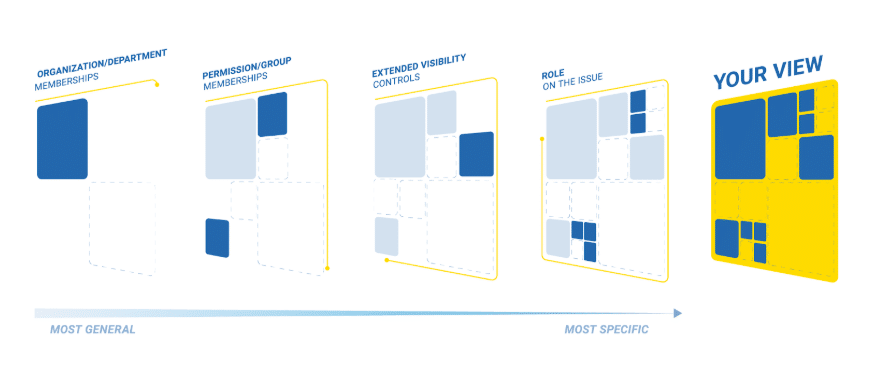Traktip: Managing Visibility in Issuetrak

Open visibility throughout a company can be important in some cases. However, there are instances where sensitive information requires there to be only a certain set of eyes on a particular issue -- or perhaps many issues, depending on your industry.
Issuetrak provides a layered structure of visibility controls, from the most general to the most specific. The diagram below shows the different layers and their place on the scale:

We’ll walk you through the four main methods for setting visibility in Issuetrak!
Organization / Department Membership
Organizations and Departments are the two broadest categories that determine issue visibility.
Organizations are large entities that users can be added to. Organizations can be internal, which prevents members from viewing issues in other organizations, or non-internal, which allows members to view issues in other organizations.
To toggle an Organization’s “internal” settings, click the gear icon in the top right corner. Select Organizations from the Entities category in the settings lightbox. Select List from the right menu. In the next screen, click edit on the Organization you want to change. Click the checkmark next to “Internal Only” to toggle.
Departments, much like the departments at any company, are smaller groups within an organization. For departments, visibility can be set based on the department of an issue’s submitter or the department of an issue’s assignee.
To turn on Departments and change the visibility settings, click the gear icon in the top right corner. Select Departments from the Entities category in the settings lightbox. Click Use Departments and indicate which visibility rule you prefer.
Permissions / Group Membership
Permissions let you control how certain users interact with Issuetrak. They can be set per user or determined based on group membership. The most important permission pertaining to issue visibility is “Can view issues submitted by other users.” With that permission, the user’s visibility is set at the organization and department level.
For example, a user that has this permission turned on in an internal organization will be allowed to see the other issues within that organization. A user without that permission will only be able to see the issues they are involved in.
For more information about managing and setting permissions, view our Help Center article on the topic.
Extended Visibility Controls
There are some features of Issuetrak that provide the option to bend or create exceptions to visibility roles determined by the above settings.
Using the Projects feature can restrict visibility to only users involved with a particular project.Subscriptions and subscribers can also be used to set visibility for users included on the list.
“Additional orgs allowed” lets you extend the visibility of users in an “internal only” organization, allowing them to see issues in selected additional organizations.
User's Role on the Issue
Finally, a user’s role will impact their visibility on any issue. If a user has a role (submitter, assignee, task assignee, enterer) on an issue, they will always be able to see that particular issue.
And there you have it! Issuetrak provides plenty of ways to ensure everyone on your team can see exactly what they need to see -- and nothing that they shouldn’t.
If you have any more specific questions about issue visibility, reach out to your Account Manager and they’ll be happy to discuss with you!
If you're not yet a customer, please contact our Product Experts to see our visibility control and other useful features in action!
Topics from this blog: Traktips
Back